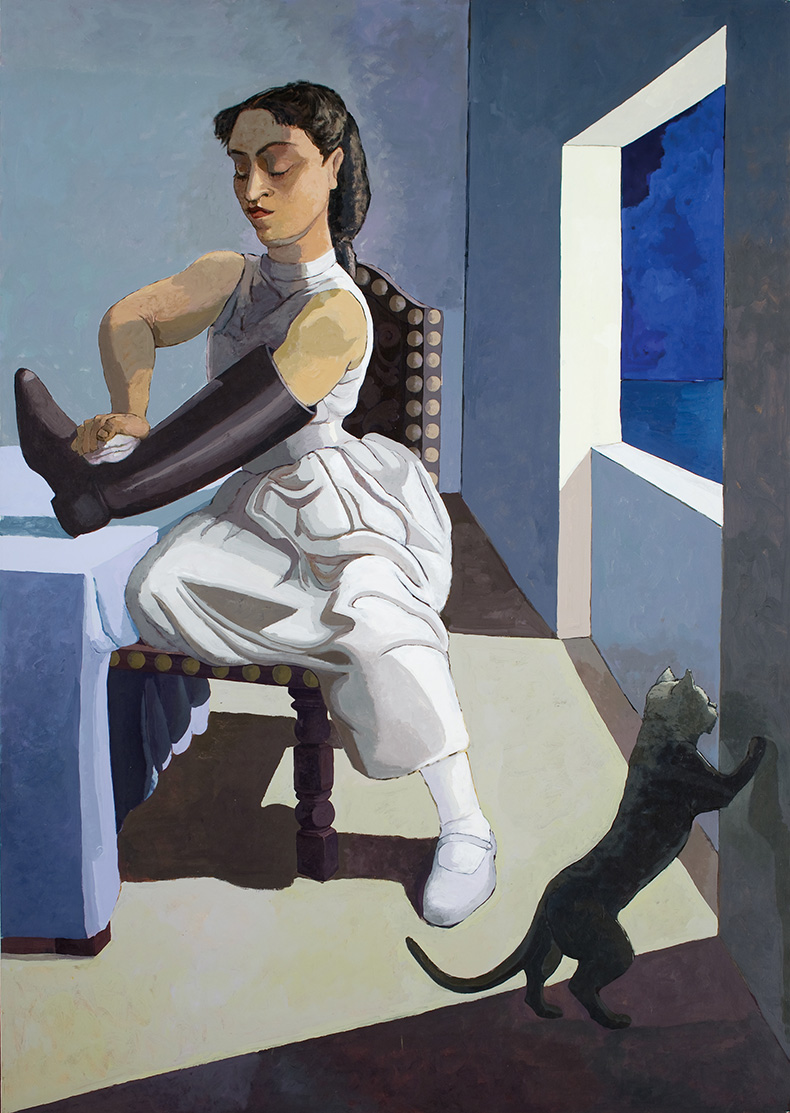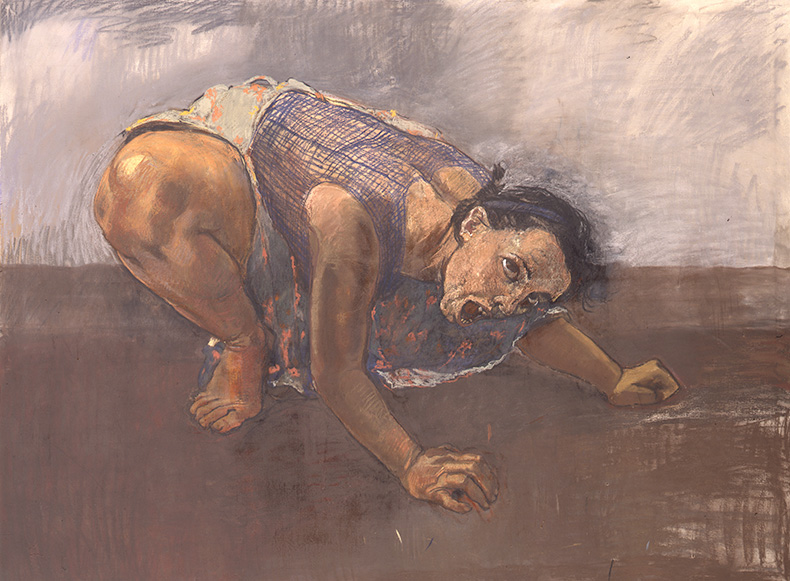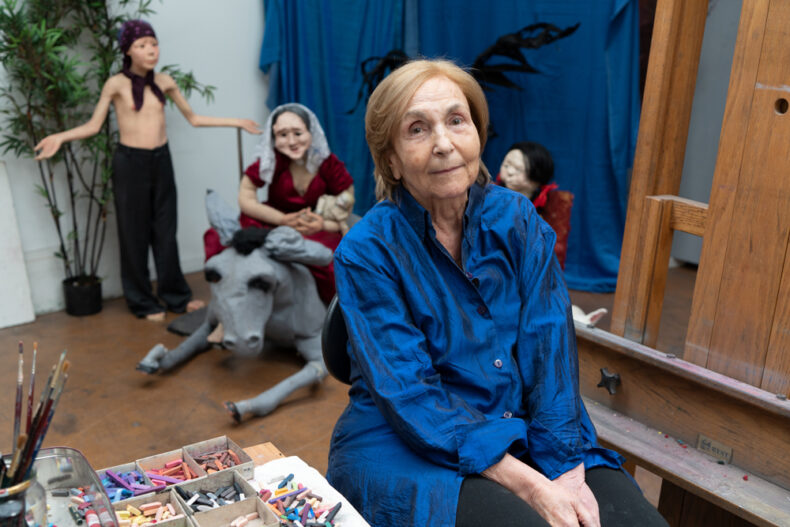An irony of Paula Rego’s career is that the three artists with whose work hers is inevitably bracketed – Lucian Freud, Frank Auerbach and David Hockney – were all men. Yet Rego, who has died at the age of 87, devoted her art to subverting masculinity: social, sexual, religious, artistic. ‘I’m interested in seeing things from the underdog’s perspective. Usually that’s a female perspective,’ she said.
Lumping her with Hockney and the rest was critical laziness. Rego, like them, was broadly a British painter, and figurative: admission to an all-male pantheon was meant as a measure of her success. And yet a better match might have been with Louise Bourgeois, whose work, like Rego’s, told a story of parental abandonment, misogyny and exile via a cast of Jungian archetypes.
Rego, an only child, was born to a liberal family in Lisbon in 1935, three years into the right-wing dictatorship of António Salazar. When she was 18 months old, her father, José, an electronic engineer, was sent by his employers to London; his wife, Maria, went with him, leaving Rego in the care of her grandmother. It set a pattern of absence and abandonment that would last throughout her childhood. In 1951, Rego’s Anglophile parents sent their 16-year-old daughter to a finishing school in Kent. Intent on being an artist, she applied from there to the Slade School of Fine Art in London. ‘Girls never get pregnant at the Slade School of Fine Art,’ her guardians had reassured Rego’s anxious parents.
This proved something less than the truth. At the Slade, Rego met Victor Willing, a student six years her senior, and already married. As she later told her son, the film-maker Nick Willing, Victor had taken her into an empty room at a party and brutally deflowered her. ‘There was blood everywhere and he didn’t even get her a cab home,’ a pained Nick Willing says in his film, Paula Rego, Secrets and Stories (2017). ‘It was closer to rape. It was horrible.’ By 1956, Rego was pregnant. Victor Willing left his wife, and the couple went back to Portugal to raise their child, a daughter. Two more children would follow, and Rego and Willing married in 1959.

The Policeman’s Daughter (1987), Paula Rego. Courtesy the artist and Victoria Miro; © Paula Rego
If their marriage was hardly the stuff of Hollywood romance – ‘Mum always did whatever he wanted,’ their son says. ‘He never told her he loved her, and shagged her best friend’ – it did provide her with a template for the female figure in her work.
At the Slade, she had been taken under the unlikely wing of L.S. Lowry, by then seen as hopelessly kitsch. Lowry, Rego said, understood her impulse to tell stories, unlike her tutor, Victor Pasmore, who ordered her towards abstraction with the words: ‘Nobody does things like that anymore. That is total rubbish.’ In 1966, in the throes of a catastrophic depression, she would find the language for her storytelling when she embarked on a two-decade Jungian analysis.
The result was a cast of archetypal tropes, often involving animals. (Like Bourgeois, Rego would be fascinated by the spider as a figure of terror, evident in her 1989 etching, Little Miss Muffet.) Most memorable of these was the series of Dog Woman pastels she produced in 1994, depicting women crouching on all fours and howling. These are deeply ambiguous figures, at once subservient and savage, cowed and terrifying. They were, Rego said, ‘about the love I had for my husband’. In 1966, Willing had been diagnosed with multiple sclerosis; to the other demands he had made of his wife was now added the time-consuming one of nursing. If Rego was honest about her resentment of this, she was also clear about the shift in power it involved.
Casting about for help, she had found a Portuguese woman called Lila Nunes who would help Willing to paint, eventually becoming his nurse. As Willing became more disabled, Nunes began to sit for his wife as a model. ‘The dog woman was her,’ Rego admitted. ‘I don’t know why, I just said to her: “Now crouch there, and growl.” And she did.’ It is tempting to see this new dominance as symbolic of Rego’s changed role as a wife, although the relationship between the two women was more complex than that. ‘She is really myself,’ Rego said of Nunes. ‘A maid can have power over her mistress. The meekest person can manipulate.’

Dog Woman (1994), Paula Rego. Courtesy the artist and Victoria Miro; © Paula Rego
So, too, with the female members of Rego’s family who appear in her works. Perhaps the best known of these is The Policeman’s Daughter, painted in 1987, the year before Willing’s death. The model is the couple’s daughter. ‘When [she] came to sit for me I said, “Don’t just cuddle the boot, just shove your hand down into it, just shove it in,”’ Rego recalled. ‘Because I’d seen a show by Robert Mapplethorpe, and there was this fist-fucking, and I thought, “Well that’s what she’s doing to the boot.”’ As with the dog-woman, the strong-armed heroine of The Policeman’s Daughter turns subservience into a kind of mastery.
The picture was first shown at the Serpentine Gallery in October 1988, four months after Willing’s death. It was Rego’s first major solo exhibition in a public space, and the beginning of her fame. Two years later, she became the first associate artist (artist in residence) at the National Gallery; in 2010, she was made a Dame Commander of the British Empire; there were major retrospectives of her work at the Tate in 2004 and 2021.
In Portugal, too, she became a national treasure, despite the often controversial nature of her work. Rego’s 1998 series of paintings of women having undergone backstreet terminations is widely thought to have helped win a referendum on abortion in Portugal in 2007. (The artist spoke openly of having had several abortions of her own.) In 2009, the Casa das Histórias Paula Rego (Paula Rego House of Stories) opened in Cascais, a rare example of a museum dedicated to the work of a living artist. Three years earlier, Rego had been invited by the then Portuguese president, Jorge Sampaio, to make a suite of large-scale pastels on the life of the Virgin Mary for the chapel of the Palácio de Belém, the official presidential palace in Lisbon. When a critic pointed out that she had apparently neglected to include the Crucifixion in the series, Rego sharply replied, ‘How can you do a crucifixion? If you do one it upstages everything. You cannot put it in this series. And it’s not necessary. The crucifixion is there in The Lamentation, but it’s out of the picture. So you concentrate on Mary.’

Paula Rego, photographed in 2021. Photo: © Nick Willing

‘The meekest person can manipulate’ – a tribute to Paula Rego (1935–2022)
Paula Rego in her London studio, 2021. Photo: Gautier Deblonde © Gautier Deblonde; courtesy the artist and Victoria Miro
Share
An irony of Paula Rego’s career is that the three artists with whose work hers is inevitably bracketed – Lucian Freud, Frank Auerbach and David Hockney – were all men. Yet Rego, who has died at the age of 87, devoted her art to subverting masculinity: social, sexual, religious, artistic. ‘I’m interested in seeing things from the underdog’s perspective. Usually that’s a female perspective,’ she said.
Lumping her with Hockney and the rest was critical laziness. Rego, like them, was broadly a British painter, and figurative: admission to an all-male pantheon was meant as a measure of her success. And yet a better match might have been with Louise Bourgeois, whose work, like Rego’s, told a story of parental abandonment, misogyny and exile via a cast of Jungian archetypes.
Rego, an only child, was born to a liberal family in Lisbon in 1935, three years into the right-wing dictatorship of António Salazar. When she was 18 months old, her father, José, an electronic engineer, was sent by his employers to London; his wife, Maria, went with him, leaving Rego in the care of her grandmother. It set a pattern of absence and abandonment that would last throughout her childhood. In 1951, Rego’s Anglophile parents sent their 16-year-old daughter to a finishing school in Kent. Intent on being an artist, she applied from there to the Slade School of Fine Art in London. ‘Girls never get pregnant at the Slade School of Fine Art,’ her guardians had reassured Rego’s anxious parents.
This proved something less than the truth. At the Slade, Rego met Victor Willing, a student six years her senior, and already married. As she later told her son, the film-maker Nick Willing, Victor had taken her into an empty room at a party and brutally deflowered her. ‘There was blood everywhere and he didn’t even get her a cab home,’ a pained Nick Willing says in his film, Paula Rego, Secrets and Stories (2017). ‘It was closer to rape. It was horrible.’ By 1956, Rego was pregnant. Victor Willing left his wife, and the couple went back to Portugal to raise their child, a daughter. Two more children would follow, and Rego and Willing married in 1959.
The Policeman’s Daughter (1987), Paula Rego. Courtesy the artist and Victoria Miro; © Paula Rego
If their marriage was hardly the stuff of Hollywood romance – ‘Mum always did whatever he wanted,’ their son says. ‘He never told her he loved her, and shagged her best friend’ – it did provide her with a template for the female figure in her work.
At the Slade, she had been taken under the unlikely wing of L.S. Lowry, by then seen as hopelessly kitsch. Lowry, Rego said, understood her impulse to tell stories, unlike her tutor, Victor Pasmore, who ordered her towards abstraction with the words: ‘Nobody does things like that anymore. That is total rubbish.’ In 1966, in the throes of a catastrophic depression, she would find the language for her storytelling when she embarked on a two-decade Jungian analysis.
The result was a cast of archetypal tropes, often involving animals. (Like Bourgeois, Rego would be fascinated by the spider as a figure of terror, evident in her 1989 etching, Little Miss Muffet.) Most memorable of these was the series of Dog Woman pastels she produced in 1994, depicting women crouching on all fours and howling. These are deeply ambiguous figures, at once subservient and savage, cowed and terrifying. They were, Rego said, ‘about the love I had for my husband’. In 1966, Willing had been diagnosed with multiple sclerosis; to the other demands he had made of his wife was now added the time-consuming one of nursing. If Rego was honest about her resentment of this, she was also clear about the shift in power it involved.
Casting about for help, she had found a Portuguese woman called Lila Nunes who would help Willing to paint, eventually becoming his nurse. As Willing became more disabled, Nunes began to sit for his wife as a model. ‘The dog woman was her,’ Rego admitted. ‘I don’t know why, I just said to her: “Now crouch there, and growl.” And she did.’ It is tempting to see this new dominance as symbolic of Rego’s changed role as a wife, although the relationship between the two women was more complex than that. ‘She is really myself,’ Rego said of Nunes. ‘A maid can have power over her mistress. The meekest person can manipulate.’
Dog Woman (1994), Paula Rego. Courtesy the artist and Victoria Miro; © Paula Rego
So, too, with the female members of Rego’s family who appear in her works. Perhaps the best known of these is The Policeman’s Daughter, painted in 1987, the year before Willing’s death. The model is the couple’s daughter. ‘When [she] came to sit for me I said, “Don’t just cuddle the boot, just shove your hand down into it, just shove it in,”’ Rego recalled. ‘Because I’d seen a show by Robert Mapplethorpe, and there was this fist-fucking, and I thought, “Well that’s what she’s doing to the boot.”’ As with the dog-woman, the strong-armed heroine of The Policeman’s Daughter turns subservience into a kind of mastery.
The picture was first shown at the Serpentine Gallery in October 1988, four months after Willing’s death. It was Rego’s first major solo exhibition in a public space, and the beginning of her fame. Two years later, she became the first associate artist (artist in residence) at the National Gallery; in 2010, she was made a Dame Commander of the British Empire; there were major retrospectives of her work at the Tate in 2004 and 2021.
In Portugal, too, she became a national treasure, despite the often controversial nature of her work. Rego’s 1998 series of paintings of women having undergone backstreet terminations is widely thought to have helped win a referendum on abortion in Portugal in 2007. (The artist spoke openly of having had several abortions of her own.) In 2009, the Casa das Histórias Paula Rego (Paula Rego House of Stories) opened in Cascais, a rare example of a museum dedicated to the work of a living artist. Three years earlier, Rego had been invited by the then Portuguese president, Jorge Sampaio, to make a suite of large-scale pastels on the life of the Virgin Mary for the chapel of the Palácio de Belém, the official presidential palace in Lisbon. When a critic pointed out that she had apparently neglected to include the Crucifixion in the series, Rego sharply replied, ‘How can you do a crucifixion? If you do one it upstages everything. You cannot put it in this series. And it’s not necessary. The crucifixion is there in The Lamentation, but it’s out of the picture. So you concentrate on Mary.’
Paula Rego, photographed in 2021. Photo: © Nick Willing
Unlimited access from just $16 every 3 months
Subscribe to get unlimited and exclusive access to the top art stories, interviews and exhibition reviews.
Share
Recommended for you
Paula Rego shares her secrets with her son
The artist discusses love, depression, abortion and infidelity in a new documentary directed by her son
Paula Rego paints a world of nightmares and secrets
Drawing on sources from Balzac to Disney, Rego’s pictures hint at narratives filled with mystery
Paula Rego pictures a world of pain
A survey of the artist takes us to a land of sinister magic not so different to our own